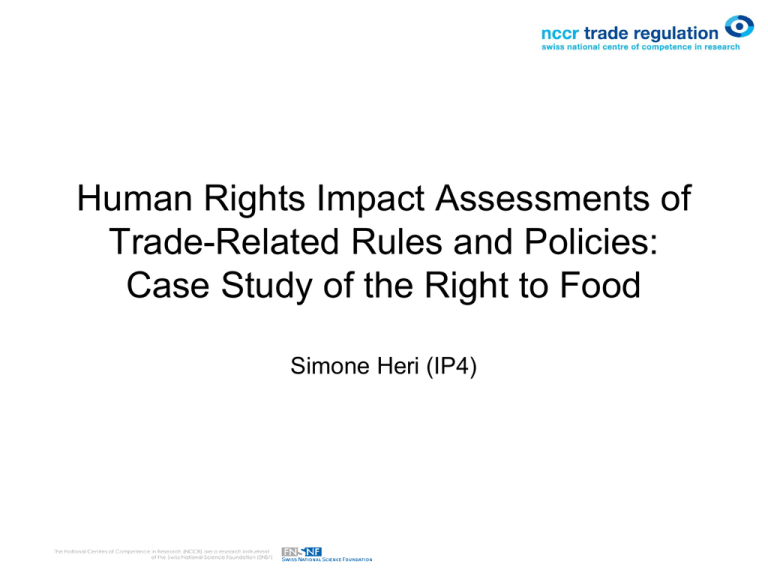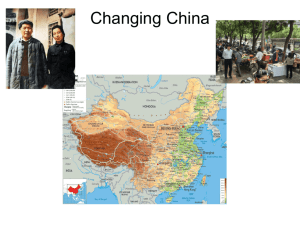Human Rights Impact Assessment of Trade-Related Rules
advertisement

Human Rights Impact Assessments of Trade-Related Rules and Policies: Case Study of the Right to Food Simone Heri (IP4) Content • Starting Point • Objectives of the PhD • Indicators of the Right to Food – Structural Indicators – Process Indicators – Outcome Indicators • Methodology • Next Steps Starting point 1/2 • States have Human Rights obligations concurrent with their commitments in the area of international trade => 150 WTO Members • 124 parties to the ICESCR • Every WTO Member has at least ratified one of the major human rights treaties • The assessment of the empirical relationship between the two regimes varies from „a veritable nightmare“ to trade being the panacea for fullfilling human rights Starting point 2/2 • Increasing calls for Human Rights Impact Assessments (HRIAs) The Committee strongly recommends […] that the State party evaluate the impact of the free-trade agreements that entered into force in 2006 on the economic, social and cultural rights of the people of Morocco. Concluding Observations of the Committee on Economic, Social and Cultural Rights: Morocco, E/C.12/MAR/CO/3 (9/2006) • To date little research has been undertaken to develop methodologies and systematic tools for HRIAs of policies Objectives of the PhD project • Develop a conceptual and methodological framework for HRIAs of trade-related rules and policies • Produce a guide on conducting HRIAs for trade-related rules and policies and apply it to case studies • Contribute to identify quantitative human rights indicators What is a HRIA? • Help people identify and assess their rights • Understand how trade reform can affect the enjoyment of those rights • Identify ways in which government can improve trade policies to fulfil human rights obligations • Identify ways in which the international community can cooperate with national governments to fulfil human rights obligation Indicators of the Right to Food • Most critical step in HRIAs: choice of indicators • A recent study chaired by Prof. Eibe Riedel identified 37 indicators of the right to food • All indicators grounded in the normative content of the right to food as elaborated in Art. 11 ICESCR, General Comment 12 and the FAO Voluntary Guidelines to support the progressive realization of the right to adequate food in the context of national food security Structural Indicators • Recognition of the right to adequate food and related rights • National strategy on implementing the right to food • Mechanisms to ensure a functioning market system • Instruments to ensure cultural or traditional food use and nutrition • Nutrition and nutrition adequacy legislation and programs • Protection and enhancement of access to productive resources and labour Mechanisms to ensure a functioning market system Possible Sub-Indicators: • Regulation of the volatility / stability of food prices (VG 4.1) • Promotion of the development of small-scale local and regional markets (VG 4.5) • Mechanisms to ensure functioning internal marketing, storage, transportation, communication, and distribution systems (VG 4.8) • Mechanisms to provide adequate protection to consumers against fraudulent market practices, misinformation and unsafe food (VG 4.4) Possible Sources of Data WTO, UNCTAD, National Administration, FAO, World Bank Process Indicators • Expenditure for rural development • Expenditure for agricultural research • Coverage of of programs to secure or prepare access to productive resources • Coverage of a social transfer scheme or food safety net • Estimate of access of women and girls to adequate food within the household • Percentage of judges, lawyers, prosecutors and administrators benefiting from education on esc-rights Outcome Indicators • Number of starvation / malnutrition deaths recorded • Percentage of malnourished population • Percentage of population living in poverty and extreme poverty • Percentage of population lacking access to productive resources • Per capita availability sourced throuf domestic production, import and food-aid • Proportion of population wh Methodology • Conceptual framework – Analysis of the legal content of the human right to adequate food – Translation into a limited number of characteristic attributes – Configuration of appropriate structural, process and outcome indicators • Methodological framework – Integrated approach: case studies, economic modelling, econometric analysis, expert opinion, stakeholder consultations – Causal chain analysis for ex ante assessments – Elasticity indicators for vulnerable groups for ex post assessments Causal-Chain Analysis Kirkpatrick, C. & George, C. (2006). Methodological issues in the impact assessment of trade policy: expericence from the European Commission‘s Sustainability Impact Assessment programme. Impact Assessment and Project Appraisal, 325—334. Elasticity Indicators Compare the percentage change in one variable, with the accompanying percentage change in another variable. Numerator: Measures changes in, e.g., gender equality - Income / - Wages - Employment (export sectors / import-competing sectors, unemployment / under-employment rates, gendered job segregation) Denominator: Measures changes in trade - Total value of trade of a country / region - Total value of trade as a share of GDP - Openness (measured as tariff reduction of x percent) See Irene Van Staveren, Gender Indicators for Monitoring Trade Agreements (WIDE Briefing Paper, February 2007). How to integrate the results of HRIAs into decison-making • Decision-Making Process at the Domestic Level – In-House Approach (e.g. Canada) – Independent studies by external consultants (e.g. EC) • Negotiations under the Doha Mandate • General Exception Clauses and Dispute Settlement Next steps • Select countries for case-studies to test the indicators • Present a paper on methodology for HRIAs of trade-related rules and policies in November








